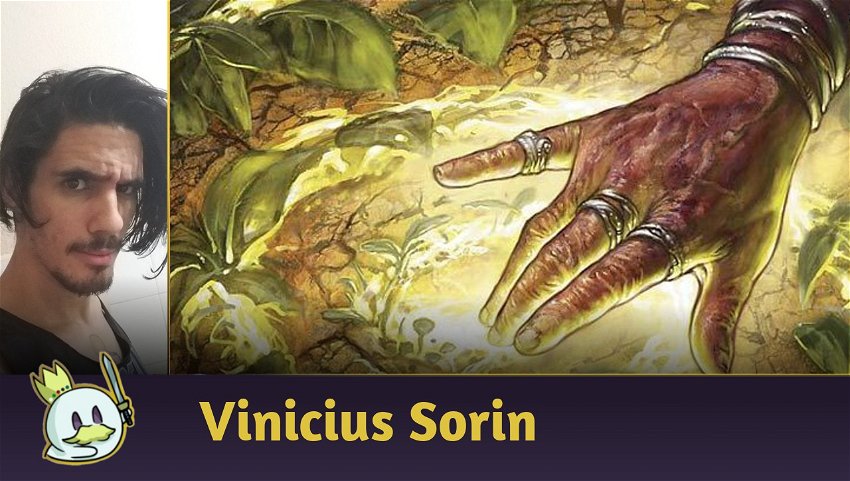Hello, readers! I'm here to bring you another episode of our series on Commander Deckbuilding, this time to talk about important card types. In the past episode, we talked about templates and functions of the most indispensable cards for any Commander deck. Today we're going to delve into one of these functions: mana acceleration. The concept of accelerators I explain in that episode, and I recommend reading it if you don't know exactly what I'm talking about.
What is Mana Acceleration?
Summing up a bit of the concept: mana acceleration are effects that allow you to reach higher mana curves more quickly. They are important in Commander, as it is customary to use really heavy spells in the format, and accelerating the mana curve ends up being a way to make it possible to cast these spells. Accelerators also help pay the additional costs of repeatedly casting a commander from the command zone. In short, using these cards makes your game easier and more fluid.
There are different types of accelerators, some better than others depending on the context. At the same time, there are cards that appear to be accelerators, but aren't. Identifying a card's function is essential in determining what space it should occupy in your deck (as explained in the previous article, in the 'Templates' section). To help you with this, I've outlined the main types of mana accelerators below, along with their pros and cons.
Mana Rocks

Mana Rocks are non-creature artifacts that generate mana (by tapping them). They are the most widespread type of accelerators because, as they are artifacts, they can generally be slotted into any deck.
In addition to their versatility of use, the biggest advantage of mana rocks is their ability to be used in the same turn they are cast (unlike mana dorks, which usually suffer from summoning sickness). This makes them very conducive pieces for explosive mana curve jumps.
On the other hand, mana rocks are easily removed by artifact interaction effects, which are generally common in Commander; much more than lands and less than creatures. Because of this, some deckbuilders try not to depend solely on mana rocks for the acceleration function, constantly looking for a balance between them and the ramps (see below).
The best mana rocks are used in virtually all Commander decks. Some have specific color identities, but they are still part of the vast majority of decks that are capable of supporting them.
Positive Mana Rocks
Positive Mana Rocks are artifacts capable of generating more mana than their own cost. They are considered the best mana rocks that exist because after playing them you will have a higher amount of mana than you had before, and you can use them immediately. However, positive mana rocks are also the most expensive accelerators (in terms of money) and so are not as common to see as the cheaper options.

Signets
The cycles of mana rocks known as Signets are 2-manaartifacts with two-color identities that not only generate but also filter your mana (see Mana Fixing below). Each of them is linked to one of Ravnica's guilds and therefore can only be used in decks that support their 2 colors.
One exception is Arcane Signet, which doesn't have a defined color identity and can be used in any deck. These mana rocks are very useful in multicolored decks, as they have low cost and are doubly useful — both to speed up and to fix your mana curve.

Other Mana Rocks
Many other mana rocks are used extensively in Commander, both for their usefulness and functionality, and for their low financial cost.
Some of the most popular are Thought Vessel, Mind Stone, Fellwar Stone, Everflowing Chalice and the monocolored diamonds (Marble Diamond, Fire Diamond, etc); Thran Dynamo, Gilded Lotus, Basalt Monolith, Worn Powerstone, Commander's Sphere, Hedron Archive, Chromatic Lantern also integrate a big quantity decks, among others.
Dorks

Dorks are creatures that generate mana on tapping. They exert the same functionality as mana rocks, with the difference that they are affected by summoning sickness (they cannot be tapped on the same turn they enter the battlefield) and are easier to remove.
Mana Dorks are generally cheaper in mana cost than rocks, with a good incidence of creatures costing the same amount of mana they can generate, which is somewhat unusual among artifacts.
This makes these cards also highly recommended options for those who want explosive and fast acceleration, even though it is usually not possible to use the dork's mana immediately after casting it.
Dorks Staples
There are very few staples among mana dorks more broadly, but the color green in particular has a wide range of these cards that are widely used as accelerators. Llanowar Elves (Elvish Mystic, Fyndhorn Elves, etc) and Birds of Paradise are just a few examples of the most common dorks, but many others exist, and it would be impossible to list them all.
In other colors, the presence of mana dorks is very modest, but there are still artifact creatures that can be used to fulfill this role. Myrs (Palladium Myr, Plague Myr, Iron Myr, etc) are a type of creature known for having reasonable quality dorks for a low cost.
Ramps

Ramps are effects that speed up your mana curve by putting lands in play, so you can overcome the conventional limitation of playing just one land per turn.
The word ramp comes from the card Rampant Growth, which is one of the classic representatives of this type of effect, although in Commander specifically the card doesn't exactly have a special relevance.
Ramps can put lands into play from your library (Cultivate), from your hand (Exploration), or, in rarer cases, from your graveyard (Splendid Reclamation). The biggest advantage of ramps is the fact that lands are much more difficult to remove than any other permanent, so they are often the safest form of acceleration. However, not many of them are available in all colors.
Ramp Staples
The best ramps are in green, with a few examples of cards effective in this role available in other colors. Solemn Simulacrum takes the forefront of them, as it is colorless and fits in any deck. Thanks to this, it can be considered the most used non-green ramp and a true Commander staple. Behind it are Sword of the Animist – excellent in creature-based decks - and Burnished Hart – which is a low-cost alternative to both of the above.
In green, as mentioned above, the staples of ramps are plentiful. The most widespread are undoubtedly Cultivate and Kodama's Reach, both very similar and efficient. Behind them are cards like Explosive Vegetation, Skyshroud Claim, Wood Elves, Nature's Lore, Burgeoning, Exploration and Oracle of Mul Daya.
Cost Reducers

As the name implies, these cards, guess what, reduce the mana costs for casting spells or other game actions that you will do with recurrence (Goblin Electromancer, Training Grounds).
They are very useful in any deck and in some cases they are better acceleration options than any mana generator (such as rocks or ramps), especially in strategies that seek to cast many spells in the same turn, as is the case with Storm.
The more spells or additional abilities that can be used in a turn thanks to a cost penalty, the more value you'll extract from it; whereas a dork or rock, for example, simply adds X amount of mana that after being used, the card's function ends until it is untapped. A cost reducer has a passive, static value.
Reducers Staples
Many cost-savers are known to be staples, but usually on specific archetypes.
Goblin Electromancer, Baral, Chief of Compliance and Primal Amulet, for example, are valued pieces in spell-based decks.
Etherium Sculptor and Starnheim Courser are often used in artifact and/or enchantment decks.
Herald's Horn, Krosan Warchief and Frogtosser Banneret are examples of good reducers in tribal decks; and so on.
Among the reducers most regarded as generic staples (which could easily play in any deck) are Cloud Key, The Immortal Sun and the Tempest medallion cycle (Ruby Medallion, Sapphire Medallion, Pearl Medallion, Jet Medallion, Emerald Medallion).
Rituals

Rituals are single-use accelerators, usually printed as instant or sorcery spells. They generate mana that must be used immediately, and then go to the graveyard.
The most classic example of the genre, and which even gives its name to this category of accelerators, is Dark Ritual, one of the first rituals to be disseminated. Many others exist today, however, such as Cabal Ritual, Seething Song, Desperate Ritual, Bubbling Muck, High Tide and Mana Geyser.
These cards provide an incremental acceleration effect similar to the aforementioned positive mana rocks, with the difference that they serve only once. They are often useful in combo decks, where victory is often decided in a single sudden play.
Rituals Staples
Despite their proven effectiveness, rituals are not used as often in Commander as other means of acceleration, as they are single-use effects.
However, as the required power level increases towards the more competitive strands of the format, rituals become more frequent and, in some cases, staples. Still, few of them besides Dark Ritual appear in a significant amount of decks.
Mana Amplifiers

This is a category of accelerators that don't have a defined ingrained name, so I took the liberty of calling them mana "amplifiers", but you can also refer to them as "enhancers", "generators", "multipliers”, “plants”... as you prefer.
These are permanents that increase the mana production capacity of your lands and/or other permanents. A good example that illustrates this type of accelerator well is the Mana Reflection enchantment. A mana booster, either global - affecting many permanents (as is the case with Reflection itself) - or local - increasing the production of a single land, rock or dork (eg Utopia Sprawl) .
Globals are generally heavier, high-impact cards in the game, dramatically accelerating your mana curve, while locals are often as punctual as a mana rock or dork.
Amplifiers Staples
There are some well-known amplifiers in Commander, mainly Caged Sun, Extraplanar Lens and Gauntlet of Power which are widely used in monocolor decks. Apart from these, the best known, for a change, are green.
The Mana Reflection quoted above is the best of them all (in my opinion), followed by Vorinclex, Voice of hunger, Zendikar Resurgent and Mirari’s Wake. Among the local amplifiers, the best known are Fertile Ground, wild growth and Utopia Sprawl.
Mana Fixing

Mana Fixing is a term used in Magic to refer to effects that "fix the mana curve". This basically means making sure you have access to the kind of mana you need, when you need it. While mana acceleration aims to increase the mana curve quantitatively, fixing works on the quality of available mana, ensuring better color balance and allowing more restrictive mana costs to be paid.
Many times, accelerators like Ramps and Mana Stones also work as fixers, as they can give you access to mana colors beyond what you already have available on the battlefield, such as Chromatic Lantern and Dryad of the Ilysian Grove. However, there are cards that only work as fixers and do not accelerate anything. This should be noted carefully, as it is very common (especially among beginners) to confuse the two and end up using certain cards as if they were accelerators, when, in fact, they are just fixers.
The most common case of a mana fixer is the land tutor, which are very similar to Ramps with the difference that they put lands in your hand instead of on the battlefield (Armillary Sphere, Journeyer's Kite). This distinction is relevant, as having more lands in your hand doesn't really mean accelerating your mana curve, but cards like the two examples above are still useful for chasing lands of a certain specific type that you might be missing from your game.
Other examples of mana fixers in addition to those already mentioned include Prismatic Omen, Joiner Adept, Urborg, Tomb of Yawgmoth, Yavimaya, Cradle of Growth, Celestial Dawn, Mycosynth Lattice and Realmwright.
Conclusion
I hope I helped you understand a bit more about mana boosters. I look forward to your feedback in the comments and would like to know what types of boosts you most like to use in your Commander decks. In the upcoming episodes, we will break down yet another card function.














— Comentarios 0
, Reacciones 1
Se el primero en comentar